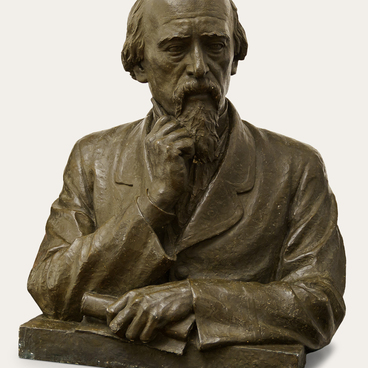The collection includes a mahogany two-tiered and single-door buffet cabinet.
The upper tier is decorated with twisted half-columns, has two removable shelves and a glass door. The lower tier has one removable shelf and a panel wooden door. The cabinet sits on a frame with shaped legs. On top, it is decorated with a concave cornice.
The cabinet was donated to the museum by the poet’s niece Vera Andreeva, née Nekrasova. She claimed that piece of furniture had long been in the Karabikha estate and used to store dishes.
Along with the cabinet, Vera Andreeva donated several items that had belonged to the Nekrasov family: porcelain plates, a bread basket, a coffee pot, a sugar bowl, glasses, and a silver teaspoon. The poet himself used some of them. Currently, these dishes and other cutlery are displayed in the cabinet.
The cabinet was restored by the Grabar Art Conservation Center in 1974: dirt was removed, the missing veneer was inserted, and a special protective layer was applied.
Currently, the cabinet is displayed at the top of the stairs in the East Wing, which leads upstairs to where the poet’s personal rooms were. During Nekrasov’s life there was a cupboard with dishes there.
The landing on the second floor of the East Wing served as a pantry: here dishes were brought to be served in the dining room. Most often Nekrasov and Zinaida Nikolayevna, his future wife, with whom the poet usually came to Karabikha for the summer months since 1870, dined together. Sometimes they were joined by relatives and friends, including his sister Anna, his brother Konstantin, the playwright Alexander Ostrovsky, and the writer Mikhail Saltykov-Shchedrin who also visited the estate.
During that period, Nekrasov
led a solitary life, devoting a lot of time to writing and corresponding with
fellow writers. If there was a break in work, the following custom had been
established among the brothers: one day they dined together in Fyodor’s Manor
House, and the next day they had a meal at Nikolay’s place.



